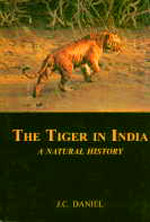| Bookshelf The Tiger in India - A Natural History ~ J.C. Daniel |
|||||
J.C. Daniel's latest book, The Tiger in India draws on archival records to produce a comprehensive natural history volume on the striped predator. The volume primarily takes a look at the tiger during an era when the barrel of the gun ruled over these mighty animals. Collating available information from the early issues of the Journal of the Bombay Natural History Society, the author presents a book that reflects a time when the tiger was an animal "not on the verge of extinction" but rather "to be exterminated as a menace to man and human interests". |
Book Reviews • Karadi Tales • So Far • Fasting,Feasting • Love in a Dead Lang • Weretiger • The Tiger is a Gent • Snakes & Ladders • The Other Tongue • Where Streets Lead • Village Before Time
Author Interviews | ||||
 The book documents the tiger's life, hunting expeditions and the gradual
decline of its populations through the recordings of various writers. The
opening section discusses the origins and history of the tiger with
subsequent chapters dealing with the different races, the tiger's
distribution and population, vital statistics and behaviour. The book also
has separate sections on man-tiger conflicts, man-eating tigers and hunting.
The choice of writings once again emphasise that the hunters of yesteryear
have made some of the most accurate observations on India's wildlife. Some
of the behaviour descriptions that the author reproduces are particularly
interesting, such as excerpts from W.D. Ritchie's articles about an unusual
fight between a tiger and a tigress, a classical encounter between a tusker
and a pair of tigers, described by E.A. Smythies and Sardar Bhupendra Kumar'
s account of why a tiger would choose the porcupine as prey. The reproduced
excerpts allow the reader to enjoy the flavour of a bygone era and easily
find details on various aspects of the tiger's life written by a whole range
of keen observers, without having to browse through too many historical
records. Colour and black-and-white plates have also been used in the
volume.
The book documents the tiger's life, hunting expeditions and the gradual
decline of its populations through the recordings of various writers. The
opening section discusses the origins and history of the tiger with
subsequent chapters dealing with the different races, the tiger's
distribution and population, vital statistics and behaviour. The book also
has separate sections on man-tiger conflicts, man-eating tigers and hunting.
The choice of writings once again emphasise that the hunters of yesteryear
have made some of the most accurate observations on India's wildlife. Some
of the behaviour descriptions that the author reproduces are particularly
interesting, such as excerpts from W.D. Ritchie's articles about an unusual
fight between a tiger and a tigress, a classical encounter between a tusker
and a pair of tigers, described by E.A. Smythies and Sardar Bhupendra Kumar'
s account of why a tiger would choose the porcupine as prey. The reproduced
excerpts allow the reader to enjoy the flavour of a bygone era and easily
find details on various aspects of the tiger's life written by a whole range
of keen observers, without having to browse through too many historical
records. Colour and black-and-white plates have also been used in the
volume.
Unfortunately, only one chapter has been devoted to the future of the tiger and does not include much contemporary data on the tiger. In the last few pages, the author writes about the tiger's struggle for survival and concludes, "How long the tiger will survive in the new millennium depends on how intelligently the problems facing its survival are managed. Judging from the present achievement, the future is bleak."
|
|||||
|
|
|||||
Editor: Romola Butalia (c) India Travelogue. All rights reserved. |
|||||